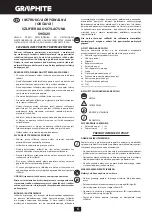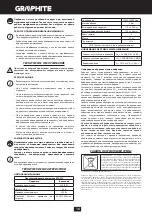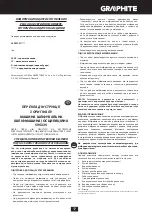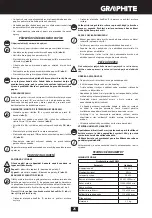
10
TRANSLATION OF
THE ORIGINAL INSTRUCTIONS
FINISHING SANDER
59G325
CAUTION: BEFORE USING THE POWER TOOL READ THIS MANUAL
CAREFULLY AND KEEP IT FOR FUTURE REFERENCE.
DETAILED SAFETY REGULATIONS
When sanding wood and metal surfaces coated with paints
with lead additives, harmful or toxic dust may arise. Contact or
inhalation of the dust may endanger operator’s or other persons’
health. Use appropriate personal protection measures such as
filter masks and safety glasses. Use dust extraction system.
PRIOR TO SANDER OPERATION
•
During operation hold the sander firmly with both hands.
•
Make sure the sanding paper does not touch processed material
prior to switching the sander on.
•
Make sure the abrasive paper is well installed and paper clamping
levers are in locking position before switching the sander on.
•
Do not touch moving parts of the sander.
•
After switching off, do not put away the sander until all moving
parts stop.
•
Use protective mask if the dust appears during sanding. Dust,
which appears when sanding surfaces coated with lead-based
paint, some types of wood and metal, is harmful.
•
Pregnant women and children should not enter the room where
lead-based paint is removed with the use of sander.
•
Do not eat, drink or smoke in the room where paint with lead
compounds is removed with the sander.
•
Avoid using long extension cords.
WHEN OPERATING THE SANDER
•
When using the sander, always wear earmuff protectors and
protection half-mask.
•
Sander is not designed for wet operation.
•
Make sure the switch is in the OFF position before plugging the
sander to a power supply.
•
Keep the power cord away from moving parts of the sander at all
times.
•
Use safety goggles or glasses when operating the sander above
head.
•
When operating the sander do not apply excessive pressure that
might stop the tool.
CAUTION! This device is designed to operate indoors.
The design is assumed to be safe, protection measures and
additional safety systems are used, nevertheless there is always a
small risk of injuries at work.
CONSTRUCTION AND USE
Finishing sander is a power tool driven by a single-phase commutator
motor. The sander does not require earth lead (insulation class II). The
finishing sander is designed for surface sanding of wood products,
polishing wood surfaces with lacquer coating, fine polishing of
lacquered metal surfaces, removal of rust or specks of lacquer before
applying new lacquer, etc. Range of use covers repair and building
works, woodworking and any work from the scope of individual,
amateur activities (tinkering).
Do not use the sander for sanding surfaces that contain
magnesium or asbestos, or covered with gypsum.
DESCRIPTION OF DRAWING PAGES
Below enumeration refers to the device elements depicted on the
drawing pages of this manual.
1.
Wheel for oscillation control
2.
Front handle
3.
Switch
4.
Main handle
5.
Dust container
6.
Sanding paper clamp
7.
Pad
8.
Holes for dust extraction
9.
Dust container installation button
10.
Dust container cover
11.
Cover locking buttons
12.
Filter
* Differences may appear between the product and drawing.
MEANING OF SYMBOLS
CAUTION
WARNING
ASSEMBLY / SETTINGS
INFORMATION
EQUIPMENT AND ACCESSORIES
1.
Dust container
- 1 pce
2.
Abrasive paper
- 1 pcs
PREPARATION FOR OPERATION
CHOOSING SANDING PAPER
Coarse-grained abrasive paper is generally used for coarse
processing of most materials, while fine-grained paper is used for
finishing works.
•
When the surface is not flat, start the work with coarse-grained
sanding paper and continue until the surface is flat.
•
Next use middle-grained paper to remove traces of coarse
processing.
•
To finish the work use fine-grained sanding paper.
INSTALLATION OF SANDING PAPER
Disconnect the power tool from power supply.
•
Select sanding paper gradation appropriate for the planned task.
•
Loosen sanding paper clamps (
6
) (
fig. A
).
•
Fix the sanding paper on the sander backing pad (
7
).
•
Make sure that the holes on the sanding paper (
8
) and the backing
pad (
6
) match fully (
fig. B
).
•
Bend both ends of the sanding path on the sander backing pad
edges.
•
Tighten the sanding paper clamps (
5
) (
fig. C
).
•
Make sure the sanding paper is installed properly.
Sanding paper must fully adhere to the sander backing pad.
There must be no slack. If the paper stretches during sanding,
remove the slack. It will significantly prolong the lifetime of the
sanding paper.
DUST EXTRACTION
The sander is equipped with hook and loop attachment pad.
Equipment of the finishing sander includes dust container (
5
)
that helps to maintain the processed surface clean. Use properly
matched, perforated sanding paper, so the dust can reach extraction
hole through the backing pad.
Содержание 59G325
Страница 2: ...2...
Страница 4: ...4 1 2 3 4 7 6 5...
Страница 5: ...5 A 6 7 B 8 7 C 7 6 D 5 9 PRESS E 10 11 11 5 F 10 12 5 G 5 9 H 3 3 4 I 1...
Страница 15: ...15 II 1 2 3 4 5 6 7 8 9 10 11 12 1 1 2 1 6 A 7 8 6 B 5 C 5 9 5 D 10 11 E 12 10 F 10 9 G 3 I 3 0 H 1 1 6 1 I 1 1...
Страница 18: ...18 10 9 G 3 I 3 0 H 1 1 6 1 I 1 1 4 2 1 1 2 1 6 A 7 8 6 B 5 C 5 9 5 D 10 11 E 12 10 F...
Страница 38: ...38 1 1 2 1 6 A 7 8 6 B 5 5 9 5 D 10 11 E 12 10 F 10 9 G 3 I 3 0 H 1 1 6 1 I 1 1 4 2...
Страница 45: ...45 1 1 2 1 6 A 7 8 6 B 5 C 5 9 5 D 10 11 E 12 10 F 10 9 G 3 I 3 0 H 1 1 6 1 1 1 4 2...
Страница 54: ...54...
Страница 55: ...55...
Страница 56: ......











































